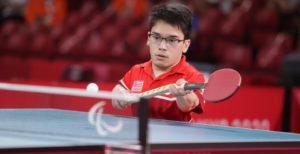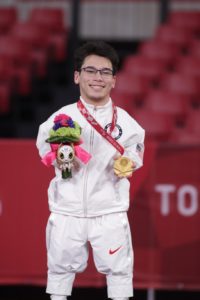Ian Seidenfeld is competitive. You don’t reach the Table Tennis gold medal match at the Tokyo Paralympic Games without that kind of competitive drive. But facing the defending gold medalist and current world champion who had already beaten Seidenfeld earlier in the Games, the Minnesotan was just happy to be there.
“I was happy to be in the final,” Seidenfeld said. “I like table tennis and competing is fun for me. When you’re in the Paralympic finals, it’s the greatest place to be for a competitor,” he said. “I wasn’t much focused on winning until…actually there never was a focus on winning.”
Seidenfeld upset Peter Rosenmeier of Denmark, sweeping the best-of-5 game match 3-0.
“The feeling that I had was really joy that I got the opportunity to play the match,” he said. “And then I was up 10-6 and one more point would finish it and I was focused on getting that one more point.
“I knew he was good but, I knew I could beat him if I stuck to the game plan.”
Winning the gold medal in the Class 6 Table Tennis at the Paralympics last month puts him in good company within his own family. His father and coach, Mitch, was the 1992 Paralympic champion in Barcelona in Class 8, silver and bronze medalist in Atlanta in 1996, and the 1990 World Champion.
The father, however, almost jinxed it for the son.
“If you watch in the video, after Ian goes up 10-6 I bend down to get my phone, which I would never do as a coach,” said Mitch. “I figured, you know, nobody ever took any pictures of me when I was competing. And I wanted to have that shot of him winning. And so I bent down to take my phone out there take my phone out of my backpack. And then he went and lost the next two points. So I put the phone down, got back to coaching a little bit.”
Balancing Parenting And Coaching
As soon as Seidenfeld’s last shot was unable to be returned by Rosenmeier, the 20-year-old American dropped his paddle and ran to celebrate with his father.
“I had never, like, hugged my dad after a match, so and that was kind of the first thing that I wanted to do after winning was to go over and celebrate with him,” he said. “In that tournament, we got a lot closer as a player and coach relationship. We are pretty close as a father and son, but we don’t work as well together as we did in that tournament. Usually, we’re fighting a little bit more, or we’re arguing or I’m not listening. But there were a set of circumstances that kind of forced us to make it just it was me and him against the tournament against the world in some ways.”
Said Mitch: “We aren’t a huggy family. Or at least he and I don’t hug. But I think we both felt that same thing. I was glad that happened.”
Mitch, the president and CEO of the Minnesota Table Tennis Federation, conceded that being Ian’s father and coach at the same time can be a challenge.
“I never forced him to play, although I did enjoy that he wanted to play,” he said. “But I was never the kind of coach that was ordering him to play a certain number of hours. There was never a time where if he didn’t feel like playing that I would go make him play. It wasn’t that hardcore kind of thing.”
By the time the pair got to Tokyo, the pair seemingly balanced the father/coach and son/athlete dynamic.
“I really wanted to enjoy his experience there as a father as much as, my responsibilities as the head coach,” Mitch said. “I allowed myself to just be a dad. And I know that from that point of view, he really just always wanted to know that I was in his corner and supporting him. I think that part of what I could offer him has always been more important to him. And I didn’t realize that completely until Tokyo; it was really amazing how he became this really disciplined player at the last minute. And I sort of figured out this father/coach thing at the last minute,
“For many years, I just thought, the best thing I can offer him is all my technical knowledge and, and all the experiences I’ve had, whether it’s winning or losing. And really all he wanted to do was look over there and know I was proud of him and I thought he was doing well.”
A Tough Start
Ian’s journey to Paralympic champion started before he could see over the edge of the table. Playing against able-bodied kids, Ian winning a match was a rarity.
“Every Saturday, I was running a juniors program, and he wanted to be there whether to hang out with me or the other kids,” Mitch said. “But his head wasn’t even up to the table.”
The decision of Ian to play was tough on Mitch.
“I was happy that he wanted to play. But I also knew that he was so competitive in a lot of different ways that it would be really tough on him starting that young and, and he ended up taking, couple years of losses,” Mitch said. “It was just loss after loss after loss. And it was really hard on him.”
Mitch said there was the occasional opponent who would ease up to give Ian an opportunity to taste success, which was enough to sustain Ian through some lean years. But Mitch — as a competitor, coach, and parent — was worried.
“The problem that added to it was that Ian isn’t the type to make excuses for himself. And I tried to give him that excuse, like ‘wait until you’re a little taller and then you’ll beat those guys,’” Mitch said. “But he wasn’t really patient like that. And he just wasn’t willing to accept that he couldn’t beat these opponents until he got taller.”
Mitch put in a lot of work to find opportunities for Ian to succeed, often driving to tournaments hundreds of miles away so that Ian could pick up a win. It wasn’t until he was 12 that Ian played in his first para-table tennis tournament. While that didn’t make him instantly better, it helped him realize the possibilities.
“I think the combination of the quality of the event but also the fact that he could see that everybody there had some sort of disability, that even though they were all much bigger than him and still too difficult for him to beat, he could see a light at the end of the tunnel,” Mitch said.
Fighting More Than His Opponents
Table Tennis at the Paralympics is divided into 10 classes. Mitch Seidenfeld explained that Classes 1-5 are for wheelchair athletes and 6-10 for standing athletes. The lower the number in each class, the more severe impairment.
“Ian is in the lowest standing class because he is affected in all his limbs,” Mitch said.
Said Ian, with a laugh: “From our understanding, I’m really disabled.”
Ian calls himself a low-end Class 6 because of his short limbs. He has pseudoachondroplasia, a type of dwarfism. He said that many with this condition have joint problems because they don’t have cartilage and their hips aren’t properly formed. His short stature led to a competition problem that has plagued him for several years.
Starting at a 2019 tournament in Spain, he was short served — serves made to drop just over the net and spin back towards the side in which came — which are extremely difficult for him to reach because of his size. The Seidenfelds had derived a work-around: A custom-created paddle extension that would help him reach a short serve. But an opponent protested the extension and lobbied a match referee to block him from using it.
“It set the precedent that anyone in my class could use [the short serve],” he said. “I saw at least half the people practicing short serves in the practice hall. It was pretty traumatic.”

Ian Seidenfeld using the extension he and his father Mitch, made for his paddle. (Photo courtesy Ian Seidenfeld. Photo by Cheng Howe Seet/ITTF)
The Seidenfelds worked on getting the extension optimized so that Ian could use it at the Paralympics. It wasn’t needed in the first match, a grueling 5-game loss to Rosenmeier. He needed to win his second match in the three-man group stage just to advance for the opportunity to win a medal, and it was a very stressful night before the match.
“I got three hours of sleep and needed to win just to get out of the group.,” he said. “If I lose then all the training for the last three or four years is worthless.”
In that match, he went up against a player who protested the use of the extension.
“We had to argue whether we could use it. As I immediately brought it out, the umpires said ‘we have to talk about it’,” Seidenfeld said. “They halted the match for 15 minutes to convene about whether we can use. In the waiting area, I just broke down in a way that I never had. They just wanted me to beg. They don’t know what it takes to play at the level that I play. I was fed up with all that was going on.”
He got to use the extension and swept the match 3-0. But the spot that having to fight for the extension put him still bothers him.
“My reach is limited as a dwarf, and their ability to short serve can exploit it,” he said. “It’s not hard to keep it away from me. But the short serve is just a cop-out in some ways. Everyone else is tall enough to reach up to the net. It’s just saying ‘I can’t beat you any other way.’ It’s not sporting and they know it.
“In the Paralympics, the basic idea is to allow everyone with a disability to play. [My opponents] and the referees are not understanding that the main purpose is that everyone has the right to participate. That’s what we were pretty upset about.”
A Title To Defend
After upsetting the world No. 1 to win the gold medal, Seidenfeld is certainly one to watch in the 2022 World Championships — assuming everything goes according to schedule — and then the upcoming 2024 Paralympics in Paris.
“He seems more excited about it. I mean, before this, we never even talked about the future,” Mitch said. “I knew he thought about playing for two more Paralympics. Now. I think he’s excited to keep playing, but he’s found the right mix right now.”
Ian is a third-year student at the University of Minnesota where he’s studying finance and entrepreneur management. He’ll be going back to Japan for his study abroad semester in the fall.
“I decided I liked it so much I wanted to go back,” he said. “People were starting to go outside when I left, so hopefully it keeps trending that way.”


